
Marcelo Barros is an attorney at Finnegan, Henderson, Farabow, Garrett & Dunner. [Photo courtesy of Finnegan]
Prevent costly disputes caused by these common mistakes in patent license agreements.
Marcelo Barros, Kathleen Daley, Brian Kacedon and Matthew Ritter, Finnegan
Licensing and other technology transfer agreements can be critical for medical device companies that invest significantly into new technology R&D and seek and obtain intellectual property protection for those investments. But if these agreements are not carefully drafted, they can create more problems than they solve.
To avoid the common pitfalls that tend to create issues in patent license agreements, watch out for a few of the most common mistakes when drafting them.
Common drafting mistakes
First and foremost, license agreements should avoid terms that are ambiguous and vague. Imprecise language can lead to uncertainty on the part of both parties to the agreement, including on what is licensed, the scope of the license, and other terms. Such uncertainty can lead to disputes, including litigation.
As with any good legal document, the key terms in the agreement should be properly defined. For patent license agreements, key terms include licensed patents, the licensed product, any improvements included in the license grant, and any field of use limitation. Carefully defining and agreeing on those key components of the agreement can go a long way to avoiding disputes that go to the heart of the agreement.
Ambiguity or vagueness in an agreement can arise by using broad, poorly defined terms. Terms like “relating to” or “flowing from” are limitless and have no clear boundary. A careful practitioner should consider avoiding such terms or including non-exhaustive statements of what does and does not relate to, or flow from, the relevant component or device to provide boundaries and guidance for future readers.
Another source of ambiguity can come from imprecise words. This can be an issue even when synonyms are chosen. Though vocabulary variety makes for good prose, a patent license agreement should never read like James Joyce. A drafter should strive to consistently, and persistently, use precise words throughout the license agreement. The case of SiRF Technology Incorporated v. ITC is a good illustration of ambiguous language: an employee assigned to their employer “all inventions … which are related to or useful in the business of the [e]mployer.” What does it mean for an invention to be related to or useful in a particular business? As the court noted, those terms “are inherently ambiguous.” Ultimately, it took litigation to determine that the patent at issue did not belong to that employer.
Agreements involving medical device technologies can also benefit from precision when defining terms related to exclusivity, field-of-use, or improvements. For example, technologies may be used in different fields. There is no requirement, however, that the owner of the technology license all fields together. Ideally, each license agreement will be tailored to the specific field-of-use for which the licensee intends to use the technology (e.g., pulse generators used for pacing versus spinal stimulation). In field-of-use licenses, the patent holder should also seek to have the licensee promise not to practice outside the licensed field. By including such an express promise, the patent holder reduces the risk of a court finding that the licensee’s use of the technology outside its licensed field is not a breach of the agreement.
Imprecise license grants
When it comes to a patent license, the scope of the license grant is one of the most important terms as it tells the parties what conduct is permitted under the agreement. Under the patent statute, a patent holder has the right to exclude others from making, using, selling, offering for sale, and importing the patented invention. The patent holder can license all of these rights or some of them. Do the parties intend for the licensee to be able to make and sell products only, or can the licensee also import the products? The grant provision should be unambiguous in what is being licensed. Though the phrase “make, use, and sell” appears complete, it fails to include the act of importation. And language such as “practice” or “exploit” the patent should be avoided as it is not clear what actions constitute practicing or exploiting the patent. That language is not in the statute and does not specifically relate to any particular right under the statute. When drafting patent license agreements, it is recommended that drafters stick to the relevant statutory language unless the parties specifically intend to agree to less than the statutory right: for patents, emulate the language in 35 U.S.C. § 271.
Another important consideration is who is being licensed. Does the license extend to a company’s subsidiaries and related companies and what happens if the licensee is acquired by another company or acquires a company? These issues should be addressed to avoid potential disputes later.
Mistakes in payment and reporting
Another important part of a patent license agreement is the payment term. How much does the licensee have to pay? How is the amount determined? When are payments due? These are all questions that should be answered in the agreement.
Commonly, a license agreement will provide a particular royalty to be paid for each product sold. But what is the base on which the royalty is applied? The most common royalty base is the net sales price. But even such a commonly used phrase should be carefully defined to specify what deductions may be taken from gross sales to arrive at “net sales,” such as taxes, insurance, shipping, and other relevant costs.
It is also common for licenses to fail to provide for interest on late payments, or what should be done if a party overpays. Another common mistake is for the license to fail to account for situations that are not “sales,” such as leases, donations, or samples. Other mistakes to be avoided include failing to include the currency or time horizon for currency conversions, as well as the withholding of taxes.
Avoiding these mistakes will help make sure that the final license agreement reflects the parties’ intent and hopefully avoids unnecessary litigation. Given the fact that medical device technology is often licensed, it’s important to understand the common pitfalls and discuss licensing strategy early in the development of a particular technology.
Marcelo Barros is an associate at Finnegan, Henderson, Farabow, Garrett & Dunner, LLP. He focuses on patent litigation in federal courts and post-grant review proceedings before the Patent Trial and Appeal Board (PTAB) of the U.S. Patent and Trademark Office (USPTO). With a background in biomedical engineering, he brings technical versatility in working with companies in the life sciences as well as electrical and computer technology sectors.

Kathleen Daley [Photo courtesy of Finnegan]
Kathleen Daley is a partner at Finnegan with significant experience in trial and appellate litigation. She has led litigation teams and been involved in all aspects of patent litigation, in district court and the U.S. International Trade Commission (ITC), and she has argued appeals before the U.S. Court of Appeals for the Federal Circuit.

Brian Kacedon [Photo courtesy of Finnegan]
Brian Kacedon is a partner at Finnegan and a recognized authority in IP transactions. He has drafted and negotiated hundreds of agreements across all technologies and is designated as a certified licensing professional (CLP). Brian has also successfully litigated multiple lawsuits and arbitrations based on his extensive transactional experience.

Matthew Ritter [Photo courtesy of Finnegan]
Matthew Ritter is an associate at Finnegan who focuses primarily on patent litigation and patent application drafting within the electronic devices space. His technical background includes electrical and computer engineering.
The opinions expressed in this blog post are the author’s only and do not necessarily reflect those of MedicalDesignandOutsourcing.com or its employees.